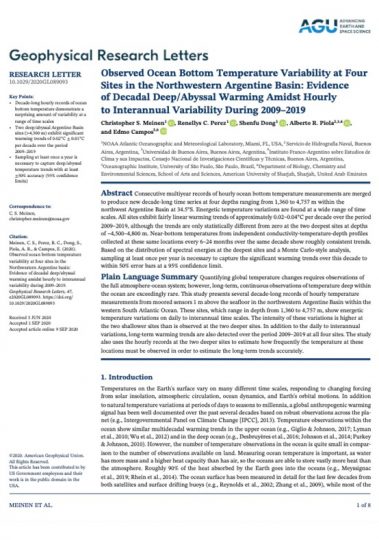Research Themes
Monitoring the Ocean Improves Hurricane Intensity Forecasts
Improvements in hurricane intensity forecasts for the Atlantic have lagged in comparison to hurricane track forecasts. Rapid hurricane intensification is often observed when tropical cyclones move over warm ocean features, given appropriate atmospheric conditions. AOML plays a key role in collecting and maintaining sustained ocean observations that monitor the thermal structure of these warm ocean features using drifters, Argo floats, XBTs, moorings, etc. Since 2014, sustained and targeted ocean observations have been gathered in support of hurricane intensity forecasts using underwater gliders.
Overturning Oceans & Societal Impacts
The overturning circulation is one of the primary ways that the oceans move heat, salt, carbon and nutrients throughout the global oceans. Achieving a more complete understanding of the behavior of the Atlantic Meridional (north/south) Overturning Circulation (AMOC) requires an observational network that spans the entire basin. Changes in the AMOC over time have a pronounced impact on a variety of socially important weather and climate phenomena, on the blue economy, and on commerce. AOML scientists have shown that these changes predict precipitation changes around the world.
Ocean Monitoring to Protect Marine Mammals and Manage Fisheries
Ship strikes are a major source of injury and death for critically endangered North Atlantic right whales. The Physical Oceanography Division has developed and currently hosts the Mandatory Ship Reporting System, which is operated by NOAA's National Marine Fisheries Service and the United States Coast Guard, to protect whales by reducing the number of ship strikes and improve overall maritime safety. AOML researchers also provide real-time ocean products that are used by NOAA's National Marine Fisheries Service to improve stock assessment and management of Atlantic bluefin tuna.
If You Like Your Weather Forecast, Thank an Oceanographer
AOML designs, implements, and maintains key components of the global ocean observing system. These ocean observations are a crucial component for weather and climate forecasts and outlooks. Variables that are typically observed are: temperature and heat content, ocean currents, eddies, and frontal regions, and salinity, surface pressure, and Meridional heat transport, and volume transport. Recent studies have shown that ocean in-situ observations in the Atlantic Ocean improve the forecast of Nor’easters more than any other observing platforms, including satellites. Without ocean observations, which provide initial and boundary conditions, weather forecasts would have large errors even at short 12-hours forecasts.
Oceanographers Help Improve Outlooks of U.S. Tornado Outbreaks
In 2013, AOML scientists found that the springtime El Niño-Southern Oscillation (ENSO) climate phenomenon generates large-scale atmospheric conditions that are conducive to intense tornado outbreaks in the United States. Since 2016, PHOD scientists have provided NOAA’s National Weather Service with a seasonal outlook for US regional tornado activity. This outlook is used as a forecast tool for the NOAA Climate Prediction Center’s experimental Seasonal Severe Weather Outlook.
Ocean Observations help Understand and Forecast extreme Weather Events
Scientist from the Physical Oceanography Division at NOAA/AOML designs, implements, and maintains key components of the global ocean observing system whose data are crucial for weather and climate forecasts. Without ocean observations, which provide initial and boundary conditions to forecast models, weather forecasts would have large errors. PHOD scientists are also working toward improving subseasonal to seasonal forecasts of extreme weather phenomena such as hurricanes, tornadoes and heat waves by using key ocean indicators and processes as the predictors.
Research Themes
Featured Projects
Physical Oceanography Data
Data from buoys, satellites, and instruments on the sea floor can be accessed on our Data page or by clicking the links below.
We are Strong because of our Community.
The Global Ocean Observing System.
AOML works with partners around the world to develop and maintain key components of these systems of observing technologies, known collectively as the Global Ocean Observing System. The resulting observations have been shown to improve weather forecasts and advance our knowledge of climate fluctuations. AOML scientists design and operate new observing technologies and systems, deploy them in the ocean around the world, coordinate deployments with partners to maximize efficiency, and manage several critical aspects of data flow to insure that the data are available and of the highest quality. Learn more about how AOML contributes to the Global Ocean Observing System.

Ocean Observations
Project Highlight
Detecting Changes in Ocean and Atmosphere
Western Boundary Time Series
AOML detects changes in the ocean and atmosphere through its global ocean observing system. Working with international and commercial partners, AOML has been able to expand long-term climate monitoring efforts that reach far beyond South Florida with non-stationary instrumentation and cruise networks. One such cruise, the Western Boundary Time Series, is a long-term observing project aids in measuring the speed of the Florida Current. This current is directly related to the Meridional Overturning Circulation, and therefore to the global climate.
Science Seminars
The Physical Oceanography Division at AOML hosts seminars to share its latest work and strengthen collaborations for an Earth Systems approach to research. Watch seminars from previous years on Youtube.
Upcoming Seminars
There are no upcoming seminars at this time.
Recent News
Featured Publication
Looking for scientific literature? Visit our Publication Database.
Technology Frontiers: Underwater Gliders
Driving Innovative Science
Project Report
This project report provides highlights of ongoing research projects that are either led by or involve AOML scientists together with essential science support personnel from NOAA, the University of Miami/Cooperative Institute for Marine and Atmospheric Studies (CIMAS), and our international partners.








